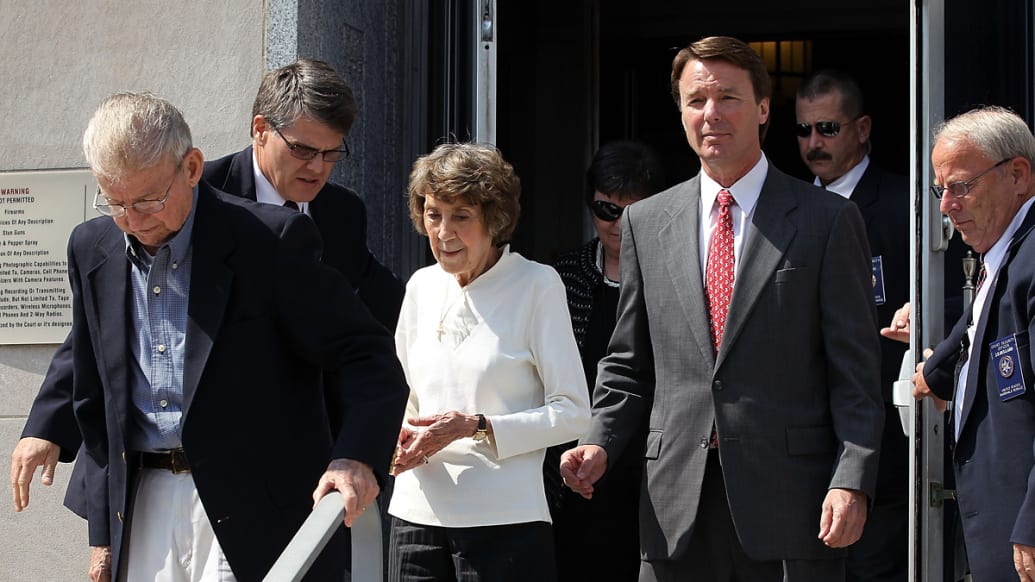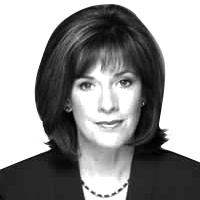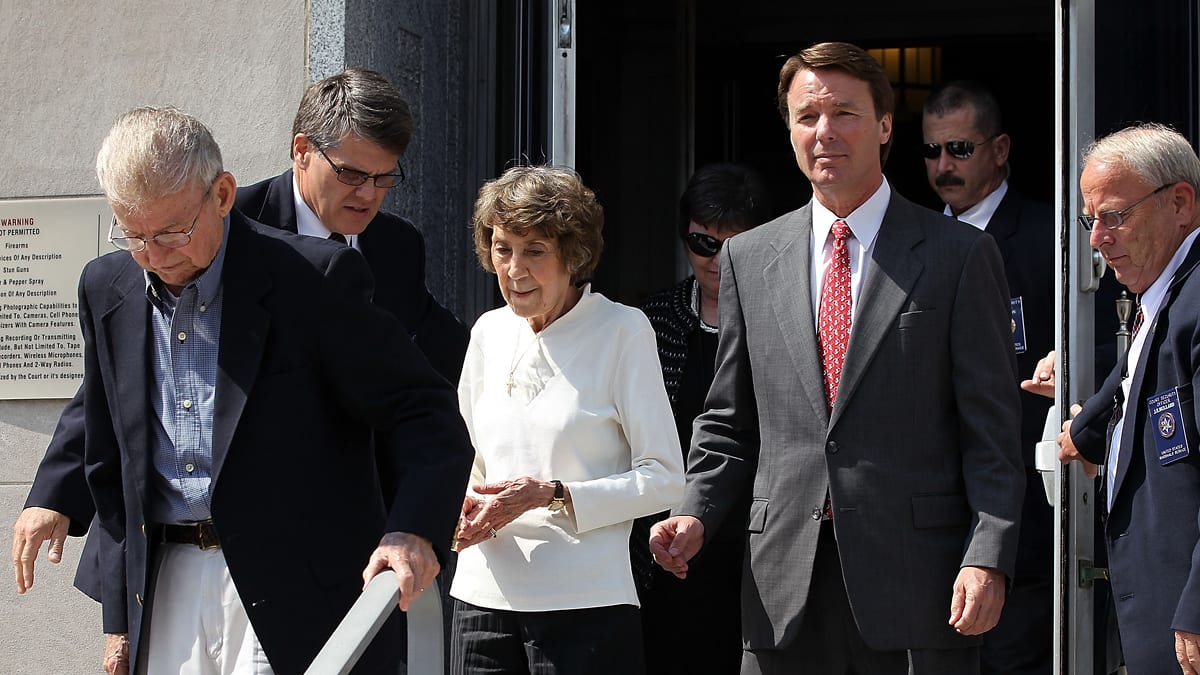No major American presidential candidate has ever faced the possibility of conviction on multiple felonies, so there are no guidelines about how such a defendant should act. John Edwards has chosen to wait out the jury deliberations in his federal campaign-financing corruption trial by going to afternoon baseball games—three days in a row.

Along with Cate, his 30-year-old daughter, Edwards has been braving the baking North Carolina sun and walking a leisurely two blocks to the Greensboro Grasshoppers’ baseball stadium, where the 2012 Atlantic Coast Conference Baseball Championships have been underway. He hasn’t stayed for an entire game, but his very presence has surprised spectators, especially when he has stopped to sign autographs. In this well-mannered Southern town (population 269,666), the very act of being so nonchalantly public during a time of such notorious legal trouble is looked upon by some as unseemly.
Then again, John Edwards is not a typical defendant, and this is not a typical case.
Inside the federal courtroom over the last week, the wait for a verdict has become excruciating at times. The Art Deco–style chamber has been transformed into a holding pen for reporters who can’t bear the thought of missing the big moment. And since Judge Catherine Eagles has never seemed eager to accommodate the media in any, members of the press don’t risk leaving the scene—during the trial, reporters who dared to exit the courtroom, even for the regular bathroom break, were required to wait at the back of a line for reentry. Few wanted to chance it; many got grumpy as a result. Now, with the end to deliberations so uncertain, and as 90-degree heat settles over Greensboro, the odor in the room has been compared to that of a locker room.
Meanwhile, peculiar behavior from some jury members has commanded special attention. The eight-man, five-woman panel sits in an elevated jury box on the right side of the courtroom. The four alternates—one man and three bubbly young women—are escorted daily to their seats on the left side of the expansive room, and are measurably more upbeat. On Thursday, as the happy-faced alternates bounced into their seats, each was wearing a bright yellow shirt. A curious coincidence? One, a pretty 20-something pharmacist, was seen smiling broadly in the direction of the defense table.
On Friday, the alternates’ shirts were once again in sync, this time a bright red. The brunette pharmacist’s form-fitting top covered only one shoulder, and again she seemed to be smiling directly at John Edwards. Then, as the main jury was brought into the room, whispers broke out in the gallery when two of the jurors were spotted also wearing red. Juror No. 7 seemed to be smiling over at the alternates. Reporters were left to wonder whether it was some sort of signal, perhaps, or a sign of solidarity. Even John Edwards had ditched the green tie he’d worn on each of the previous three days of trial in favor of a—you guessed it—red tie. It was certainly distracting, and Judge Eagles had to have noticed.
There was a surprise twist at the end of Friday’s session when Eagles suddenly announced she had “a juror matter to discuss” with the attorneys and ordered the room emptied of media and the public. Thirty-five minutes later all parties filed back in and a much more subdued group of alternates took their seats as did the 12 regular jurors. The panelists were given the usual warning by the judge not to discuss the case with anyone or read or watch any media reports about it. But Judge Eagles added an extra admonishment at this time: “As you walk back to your cars you should not talk about the case in small groups.” No further explanation was given, and spectators left wondering what coordinated color—if any—the jurors might choose to wear when deliberations resume.
So far, the jury hearing has deliberated for 33 hours over six days. After a 90-hour break for the long Memorial Day weekend, the panel may find it difficult to return to the process on Tuesday morning. No one is predicting a quick verdict—and speculation that Edwards could wind up with a hung jury is being heard more often as the days wear on.
With hundreds of exhibits to pore over, it’s impossible to know what the jury is hung up on—or what may be going through Edwards’s mind over the tortuous process.
To aid in the guessing game, The Daily Beast asked graphologist Sheila Kurtz to examine one particularly memorable piece of evidence: exhibit 912.2 (PDF), which a handwritten note on a personalized stationary card from John Edwards to Mrs. Rachel “Bunny” Mellon—one of two sources of funds at the center of the case—thanking the patroness for her hospitality. The corresponding envelope is dated Dec. 7, 2005. The handwriting on the short note is a combination of odd angled block letters and an unreadable signature.
“Dear Mrs. Mellon, I had a wonderful time visiting with you at your beautiful home. You were a gracious host. I look forward to working with you and you can help make a real difference in the country we both love. Sincerely, (signature)”
Kurtz, the director and president of Graphology Consulting Group, has analyzed samples of Edwards’s handwriting in the past, and provided a written evaluation of what she called Edwards’s “motley script.”
“If ever there was a handwriting that sets off alarm bells and sirens, it is the creepy penmanship of former senator John Edwards,” Kurtz wrote. “The most blatant characteristic of the writing is that it slants every which way, without any rhyme or reason whatsoever. There is no consistency, and there is no balance. These are the warning signals of an off-kilter and erratic mind that is floundering without a compass.”
Even a layman can see the unconnected letters and the strange angles of the note.
“There are tent-like structures (such as in the word “had” in the first sentence and in the word “forward” as last word on fourth line down) that signal a devoted stubbornness,” Kurtz wrote. “He will cling to a position he may know is dead wrong, until the last dog is hung.”
For the jury, of course, Edwards’s stubbornness to continue his illicit affair with a staff videographer named Rielle Hunter, even after several loyal staffers and his wife demanded he stop, was well established during this monthlong trial.
Kurtz and her staff first analyzed Edwards’s writing four years ago as he was vying for the Democratic presidential nomination. “I and my colleagues knew immediately that we were examining a handwriting whose writer we wouldn’t recommend for a midnight-to-eight security job at an empty warehouse,” Kurtz recalls. “The handwriting clearly belonged to an unstable, conniving, furtive, shallow creep.”
If Edwards is at all self-conscious about his handwriting, he can take solace in the fact that with six felony charges against him for the jury to ponder, it’s unlikely his card to Mrs. Mellon will decide his fate.

